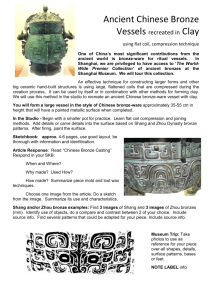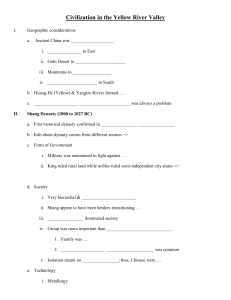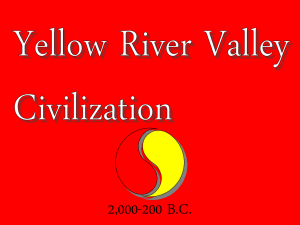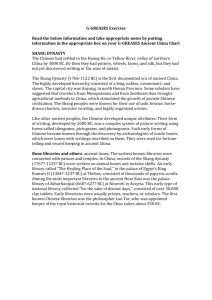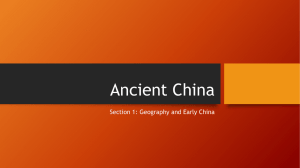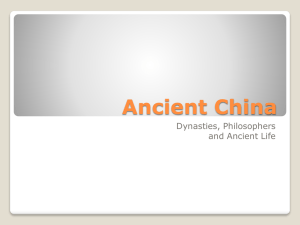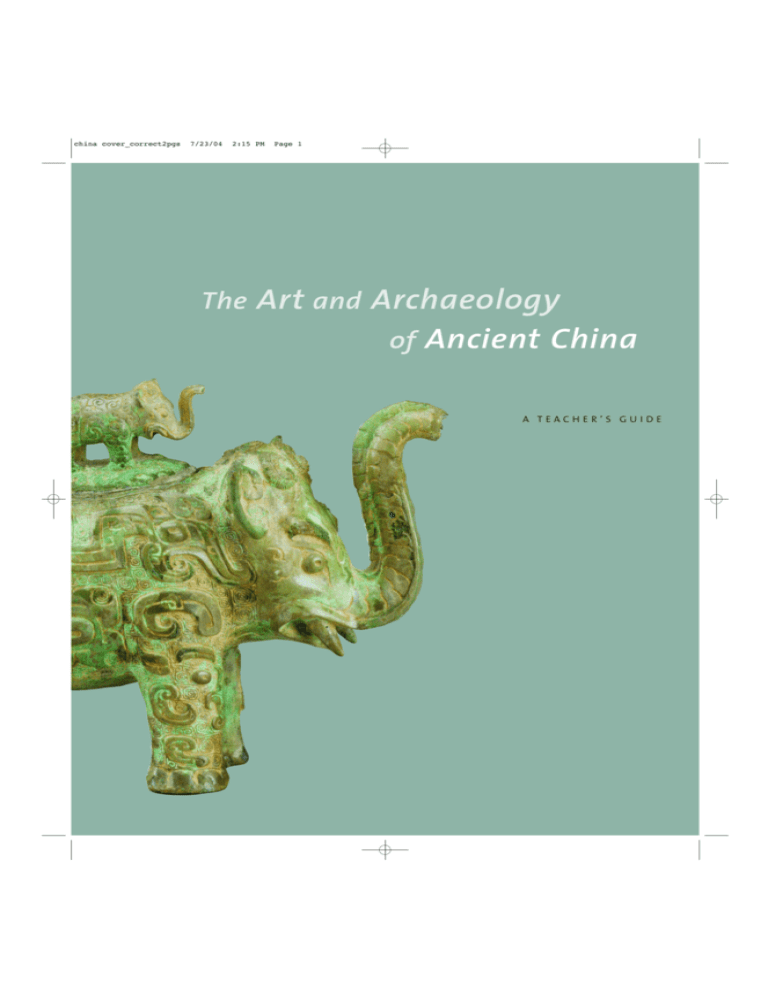
china cover_correct2pgs
7/23/04
2:15 PM
Page 1
The Art and Archaeology
of Ancient China
A TEACHER’S GUIDE
The Art and Archaeology
of Ancient China
A TEACHER’S GUIDE
Carson Herrington
WRITER Elizabeth Benskin
P R O J E C T A S S I S T A N T Kristina Giasi
EDITOR Gail Spilsbury
D E S I G N E R Kimberly Glyder
I L L U S T R A T O R Ranjani Venkatesh
C A L L I G R A P H E R John Wang
PROJECT DIRECTOR
TEACHER CONSULTANTS
Toni Conklin, Bancroft Elementary School, Washington, D.C.
Ann R. Erickson, Art Resource Teacher and Curriculum Developer,
Fairfax County Public Schools, Virginia
Krista Forsgren, Director, Windows on Asia, Atlanta, Georgia
Christina Hanawalt, Art Teacher, Westfield High School, Fairfax County
Public Schools, Virginia
The maps on pages 4, 7, 10, 12, 16, and 18 are courtesy of the Minneapolis
Institute of Arts. The map on page 106 is courtesy of Maps.com.
Special thanks go to Jan Stuart and Joseph Chang, associate curators
of Chinese art at the Freer and Sackler galleries, and to Paul Jett, the
museum’s head of Conservation and Scientific Research, for their
advice and assistance. Thanks also go to Michael Wilpers, Performing
Arts Programmer, and to Christine Lee and Larry Hyman for their
suggestions and contributions. This publication was made possible
by a grant from the Freeman Foundation.
The CD-ROM included with this publication was created in collaboration
with Fairfax County Public Schools. It was made possible, in part, with inkind support from Kaidan Inc. and a grant from the Freeman Foundation.
© 2003 Smithsonian Institution
All rights reserved.
F R O N T COV E R Detail, elephant-shaped ritual wine server. China, Yangzi
River valley, Shang dynasty, ca. 1200–1100 B.C.E. Bronze; 17.2 x 10.7 x 21.4 cm.
Freer Gallery of Art, Smithsonian Institution. Purchase, F1936.6
Table of Contents
1
Introduction
2 Overview of Ancient China
46 Threads of Ancient Practice:
Ancestor Worship Today
46 focus on Worshiping the Ancestors
47 Ancestor Worship Today: Teen Research
4 Historical Background
49 focus on Grave Sweeping Day (Qingming jie)
4 Late Neolithic Period (ca. 5000–2000 B.C.E.)
7
Xia Dynasty (ca. 21st–16th century B.C.E.)
7
Shang Dynasty (ca. 1600–ca. 1050 B.C.E.)
10 Zhou Dynasty (ca. 1050–221 B.C.E.)
52 Vocabulary
55 Pronunciation Guide
10 Western Zhou Dynasty (ca. 1050–771 B.C.E.)
12 Eastern Zhou Dynasty (ca. 771–221 B.C.E.)
14 focus on Confucianism and Daoism
16 Qin Dynasty (221–206 B.C.E.)
18 Han Dynasty (206 B.C.E.–220 C.E.)
20 Timeline
2 3 Featured Objects
24 Clothing and Personal Adornment
26 focus on Silk
5 9 Lesson Plans
60 l e s s o n p l a n 1
e l e m e n ta r y s c h o o l l e v e l a n d u p
Jing’s Gui and the Timeless Art of Gift-Giving
68 l e s s o n p l a n 2
e l e m e n ta r y s c h o o l l e v e l
Riddle of the Chinese Chimera, Dragon,
and Taotie
80 l e s s o n p l a n 3
high school level
Treasures of Ancient Chinese Tombs
27 focus on Jade
28 Food Preparation and Utensils
29 focus on Food in Ancient China
90 l e s s o n p l a n 4
middle school / high school level
Dragon-Bone Soup
30 focus on Chinese Lacquers
31 Transportation
98 Resources
33 Ceremonies
35 focus on Music in Ancient China
38 Writing
40 focus on Chinese Characters
42 Industry
43 focus on Bronze Casting
44 Building
98 The Legacy of Ancient Chinese Music:
Special Recommendations
101 Books and Magazines
103 CD-ROM
103 Videos
105 National Educational Resources
106 Political Map of China
CD-ROM: Chi’s Adventure in Ancient China (back pocket)
8 x 10-inch color reproductions (back pocket)
III
IV
ARTS OF THE ISLAMIC WORLD
Introduction
Meet Chi
This animal, with its catlike spine, fangs, long
tail, and sharp claws, is often mistaken by
Westerners for a dragon. Although it looks similar, it is actually a chimera, an imaginary
horned creature with the head of a dragon, the
body of a lion, and the wings of a bird. Inspired
by a prototype from West Asia transmitted to
China, the Chinese chimera came to symbolize
peace and prosperity.
Images of chimeras were sometimes placed in
tombs; large images of chimeras were used as
tomb guardians and were believed to protect
the deceased against evil spirits and to prevent
tomb violation. Small chimera images were
The Education Department of the Freer Gallery
of Art and the Arthur M. Sackler Gallery has
designed The Art and Archaeology of Ancient
China and Chi’s Adventure in Ancient China as
resources for educators who wish to know
more about the art, history, and culture of
ancient China.
This guide covers over five thousand years of
Chinese history from the Late Neolithic Period
(ca. 5000–2000 B.C.E.) to the Han dynasty (206
B.C.E.–220 C.E.). Naturally, we had to be selective in our approach to such an extended
period of history. We begin the guide with
background information on the Late Neolithic
Period and each dynasty through the Han.
Following that, objects from our collection are
used to illuminate aspects of ancient Chinese
society, such as clothing and transportation. In
the next section, “Threads of Ancient Practice:
Ancestor Worship Today,” we present teen
research on the contemporary practice of
ancestor worship by local Chinese Americans.
Finally, we include four lesson plans inspired
by objects featured in this volume.
This packet also includes the CD-ROM Chi’s
Adventure in Ancient China. In this virtual tour,
Chi (pronounced kai, short for chimera),
an animated chimera, introduces students to
the objects featured in the guide (see Chi
at left). It is appropriate for students aged
eight and older.
rify the memory of the deceased.
We hope that this guide will help educators
better understand early Chinese history, and
that its materials will stimulate engaging
ways to teach about life in ancient China.
A B OV E Chimera, China, Eastern Han dynasty, ca. 1st century C.E.
Bronze; 19.3 x 36.6 x 13.7 cm. Freer Gallery of Art, Smithsonian
Institution. Purchase, F1961.3
O P P O S I T E PA G E Detail, ritual wine vessel (sangzun). China, Western
Zhou dynasty, late 11th–early 10th century B.C.E. Bronze; 34.5 x 27.0 cm.
Freer Gallery of Art, Smithsonian Institution. Purchase, F1925.2
often placed in tombs as auspicious symbols.
The chimera, with its fierce beauty and association with prosperity, was also intended to glo-
Overview
of Ancient China
C h i n a i s o n e o f t h e w o r l d ’s o l d e st c o nt i n u o u s c ivi l i zat i o n s,
dating back more than seven thousand years. What is often referred to as “ancient China”
is actually a very long period of history, from approximately 5000 B.C.E. to 220 C.E. Chinese
culture, like all cultures, has always been dynamic and changing. Over the course of its first
five thousand years, China evolved from a series of Neolithic settlements into a formidable
empire, ruled by the Han dynasty (206 B.C.E.–220 C.E.), with a civil service, thriving industries, large-scale construction projects, trade with countries to the west, and exploration
to the east. This guide attempts to offer a small glimpse into China’s transformation by
examining objects that reflect its evolution.
China’s development did not involve just one cultural group in one set geographical
location. Archaeological evidence shows that many different peoples lived in the area
that now constitutes China. Some of these cultural groups became part of historically
acknowledged Chinese dynasties, such as the Zhou, who were originally based in the Wei
River valley and founded the Zhou dynasty (ca. 1050–221 B.C.E.). Other groups retained
their distinct cultures—such as the Hakka people who originally came from the Yellow
River valley but eventually settled in southern China—but still came to be considered
culturally Chinese.
How do we know about ancient Chinese life? Unlike the people of ancient Egypt who
left behind pyramids and temples, the ancient Chinese did not build monumental structures out of non-perishable materials like stone. The Great Wall—one of the best-known
examples of Chinese architecture—is one of the only monumental structures from
ancient China. However, its construction, which began during the Eastern Zhou dynasty
(ca. 771–221 B.C.E.), went through many stages of development, and it did not take its present form until the sixteenth century. Until the Zhou dynasty, from which extensive written
records survive, there were few written sources to inform us about Chinese society.
2
THE
ART
AND
ARCHAEOLOGY
OF
ANCIENT
CHINA
Detail, bell (bo zhong). China, Shang dynasty, ca. 12th–11th
century B.C.E. Bronze; 31.0 x 24.8 x 15.2 cm. Arthur M. Sackler
Gallery, Smithsonian Institution. Gift of Arthur M. Sackler, S1987.10
There are many ways of learning about ancient cultures, including the study of settlement sites, human remains, and oral and written histories. For ancient China, tombs offer
especially in-depth historic information on Chinese society over the course of thousands
of years. They not only provide information about burial rituals but also reveal information about art, cuisine, technology, scholarship, entertainment, and social classes. Like the
ancient Egyptians, the ancient Chinese had their own beliefs about the afterlife and furnished their tombs with objects that would be useful and pleasing to the dead in their next
life. The Chinese elite were often buried with jades, weapons, tomb guardians, musical
instruments, bronze ritual vessels, and ceramic architectural models and figures. They also
were buried with textiles and objects made of more fragile materials such as wood. These
materials usually did not survive, but the many objects that did give useful clues to understanding ancient China.
Objects from ancient China are, in the present day, often referred to as “art.” However, it
should be noted that what is called “art” was not necessarily made at the time as fine art—
many of these objects had ritual or practical functions when new, but gradually became
valued for their aesthetic qualities.
The discovery and study of objects from ancient China is ongoing; thus, scholars today
may draw different conclusions about objects than scholars twenty years ago. Newly excavated objects may change the interpretation of how an object was used, or how it reflected
on life at the time it was made. Regardless of how the story of ancient China continues
to evolve, archaeological and art objects remain central to our understanding of China’s
earliest history.
3
Historical
Background
Late Neolithic Period (ca. 5000–2000 B.C.E.)
Traditionally Chinese civilization is believed to have
emerged in the Yellow River valley. However, recent
archaeological evidence shows that the origin of Chinese
civilization is much more complex. During the Neolithic
Period, a number of distinct cultures lived in settlements
in today’s mainland China. Each of these cultures was
different but with shared characteristics. All were settled
agricultural communities with domesticated pigs and
dogs. The diet included staples of millet or rice, supplemented by fish and game. Finally,
there is evidence, in all of these cultures, of extensive pottery production. Ceramic vessels
like these were often placed in tombs during the Neolithic Period, suggesting that Neolithic
people placed objects in tombs to reflect the high status of the tomb’s occupant, the way
the elite of later dynasties used bronzes (fig. 1).
These cultures also produced jade objects for the elite (see Focus on Jade, page 27),
including personal ornaments, such as bracelets, earrings, and pendants, and other objects
designed for ceremonial use, such as ax heads and knives. Archaeologists also found that
the Liangzhu culture—centered along China’s southeast coast—made jade objects shaped
like disks (bi) and tubes (cong; figs. 2 and 3) in large numbers, but the actual function of
these objects is still not known. For instance, in one important tomb, thirty-three cong
were lined up end to end around the deceased. Although the reason for this configuration
remains a mystery, it is likely that it was ritual in nature.
4
THE
ART
AND
ARCHAEOLOGY
OF
ANCIENT
CHINA
Detail, ritual wine vessel (fangyi). China, Shang dynasty, 12th–11th
century B.C.E. Bronze; 19.1 x 10.7 x 7.7 cm. Freer Gallery of Art,
Smithsonian Institution. Purchase, F1954.13
FIGURE 1
Storage jar
Northwest China, Machang culture
Late Neolithic Period, ca. 2400–2000 B.C.E.
Earthenware with painted decoration, 24.5 x 21.2 cm
Freer Gallery of Art, Smithsonian Institution
Gift of Mrs. Anna C. Chennault, F1973.18
Neolithic cultures inhabited areas all over
present-day China. This storage jar is an
example of the ceramic production of the
Neolithic Machang culture from northwest
China. The jar’s geometric design of four
large circles in black and reddish-brown
is characteristic of Machang ceramics.
FIGURE 2
Ritual disk (bi)
China, Neolithic Period, Liangzhu culture
4th–3d millennium B.C.E.
Jade, 17.5 x 16.7 x 1.2 cm
Arthur M. Sackler Gallery, Smithsonian Institution
Gift of Arthur M. Sackler, S1987.929
The round shape of the bi has often been
associated with heaven by later Chinese,
but it is not known if that was its meaning
during the Neolithic Period.
5
FIGURE 3
Ritual tube (cong)
China, Neolithic Period, Liangzhu culture
4th–3d millennium B.C.E.
Jade, 22.1 x 7.5 x 7.6 cm
Arthur M. Sackler Gallery, Smithsonian Institution
Gift of Arthur M. Sackler, S1987.468
Cong, such as this one, were used in burial
rites during the Neolithic Period, but their
significance is still unknown. Jade is
extremely hard to shape, so that this
object—square on the outside and round
on the inside—reflects the high level of
Chinese Neolithic jadework and the importance of jade, as so much time was invested
in working it into this particular shape.
6
THE
ART
AND
ARCHAEOLOGY
OF
ANCIENT
CHINA
Xia Dynasty (ca. 21st–16th century B.C.E.)
By the Zhou dynasty, written texts made references to the first dynasty of China—
the Xia dynasty, founded by King Yu. Most scholars today are still awaiting definitive
archaeological evidence of the existence of the Xia, although some scholars believe that it
was based at the archaeological site of Erlitou, located on the Yellow River in present-day
Henan Province.
Shang Dynasty (ca. 1600–ca. 1050 B.C.E.)
Around 1600 B.C.E., the Shang people established the
earliest Chinese dynasty verified by archaeology. During
the Shang dynasty, many people lived in walled settlements, some of them significantly larger than those of
the late Neolithic Period. From about 1300 to 1050 B.C.E.,
the Shang royal family ruled its people from a central
capital near the town of Anyang; previously it had
been located in Erligang. Both Anyang and Erligang
were located in present-day Henan Province.
The religious life of the Shang royal family is responsible for many of the dynasty’s
objects that we have available for study today. The most important role of the Shang king
was that of spiritual go-between for the royal clan, his subjects, and the gods. In Shang
belief, the highest deity was Di, or Shang Di, a powerful force that ruled over the known
universe. Shang Di also ruled over other spirits, including nature spirits and the spirits of
royal ancestors. The king was responsible for performing rites to ensure the health and
well-being of his family and subjects. This was often done by appealing directly to the
royal ancestors, who were believed to act as intermediaries between the king and Shang Di.
Divinations were also an important part of the king’s role as a political and religious
leader. Large numbers of tortoiseshells and ox scapulae were used as oracle bones, on
which to record questions that the king would ask the royal ancestor spirits. Shang kings
asked about everything from the weather to the outcome of births, hunts, and battles
(see the oracle-bone fragment, page 41). Thus, the Shang kings performed in important
political roles by attending to issues of state through religious rituals.
The religious rites of the Shang dynasty also reflect the importance of family relationships and lineage in Shang society—a value that has persisted throughout China’s history
to the present day, as has the ritual of ancestor worship (see “Threads of Ancient Practice:
Ancestor Worship Today,” page 46). It is also significant to note that throughout Chinese
history (although changing today), dating at least as far back as the Shang dynasty,
the male lineage has been considered the most important; thus, kings almost always
HISTORICAL B A C K G R O U N D
7
conducted the formal ceremonies of worship rather than female members of the
royal family.
Bronze played an important role in both the religious and the military life of the
Shang. Religious rites, which included human and animal sacrifices, also included
offerings of wine and food presented in decorated bronze vessels. These ritual bronze
vessels were frequently buried with members of the royal family. Wine vessels were one
of the most popular bronze objects of the Shang dynasty and were often part of a set
that included other bronzes, such as differently shaped wine vessels and food containers.
The number and variety of wine vessels from the Shang suggest that wine played an
important role in Shang religious rituals (see fig. 4, opposite page).
The military relied on bronze technology for defense purposes. In readiness for potential conflicts, the Shang military force was equipped with bronze weapons and with chariots that had bronze fixtures.
During the Shang dynasty, jade continued to be highly prized. Types of jade objects
from the late Neolithic Period, including the bi and cong, were, again, made largely for
ritual functions in the Shang; however, the Shang also produced many jades for personal
ornamentation (fig. 5).
FIGURE 5
Tiger plaque
China, Shang dynasty, 12th–11th century B.C.E.
Jade, 4.5 x 9.4 x 0.6 cm
Arthur M. Sackler Gallery, Smithsonian Institution
Gift of Arthur M. Sackler, S1987.705
Similar to the jades of the late Neolithic
Period, many Shang-dynasty jade objects
were made for use as personal ornaments.
This tiger plaque was likely worn as a
pendant hanging from the waist.
8
THE
ART
AND
ARCHAEOLOGY
OF
ANCIENT
CHINA
FIGURE 4
Ritual wine container ( jia)
China, Shang dynasty, 15th–14th century B.C.E.
Bronze, 21.9 x 14.5 x 16.0 cm
Arthur M. Sackler Gallery, Smithsonian Institution
Gift of Arthur M. Sackler, S1987.41
This particular wine vessel may have been
used as a container for heating wine prior to
its consumption during religious rites performed in the Shang royal temple.
HISTORICAL B A C K G R O U N D
9
Zhou Dynasty (ca. 1050–221 B.C.E.)
Western Zhou Dynasty (ca. 1050–771 B.C.E.)
The Zhou people had their origins in the Wei River valley
in present-day Shaanxi Province. Around 1050 B.C.E. this
group conquered the Shang and established their own
dynasty called the Zhou. The Zhou shared some cultural
similarities with the Shang; most importantly, archaeological evidence suggests that they performed similar religious rituals, used bronze ritual vessels, and practiced divination. During its first 279 years,
the Zhou dynasty mirrored the Shang in that it ruled as a centralized monarchy. Also, the
kind of bronze casting and jadework characteristic of the Shang continued uninterrupted.
The Zhou used Shang bronze design as a foundation for their own decorative bronzework,
but they also introduced new motifs and shapes (fig. 6).
In 771 B.C.E., the Zhou lands were invaded by a nomadic people. In response to this
attack, some bronze objects were hastily buried in pits to protect them but were never
recovered by their owners. These pits, uncovered in the late twentieth century, have
provided archaeologists and art historians with a unique source for bronzes that were
not necessarily destined for burial in tombs. These bronzes have proved particularly
useful for their inscriptions, which were longer and more detailed during the Zhou than
anything known in the Shang (fig. 6; see also the ritual food container [gui], page 38).
At the time of the invasion, Zhou rulers fled to the east and established a new capital at
present-day Luoyang. This marked the beginning of the period known as the Eastern Zhou
dynasty (771–221 B.C.E.).
10
THE
ART
AND
ARCHAEOLOGY
OF
ANCIENT
CHINA
FIGURE 6
Ritual food container (fang ding)
China, Western Zhou dynasty, 11th century B.C.E.
Bronze, 24.3 x 18.3 x 14.9 cm
Arthur M. Sackler Gallery, Smithsonian Institution
Gift of Arthur M. Sackler, S1987.305
This square, four-legged food container is a popular Shang
type, and the taotie masks found on the legs also decorate
numerous Shang bronzes. (For a discussion of taotie masks,
see the ritual wine container [you], page 42.) However,
the snakelike creature with one head and two bodies
and the small projecting knobs are elements of Western
Zhou design.
Inside this vessel, an inscription of nine characters appears
to be a dedication of the vessel to a group of ancestors,
including “Grandfather Ding” and “Father Gui.” This dedication reflects both the rise in bronze inscriptions during
the Zhou dynasty—in comparison to the Shang—and the
continued importance of ancestral spirits.
Detail, ritual food container inscription.
Another aspect of the inscription
worth noting is the pictograph in the
upper right of the inscription (see
Focus on Chinese Characters, page 40).
The pictograph depicts a basin in
which a kneeling figure holds a shaft
decorated with a trident and an
unfurled banner. Its large size and pictorial quality suggest that it is a clan
sign. The clan—a large group with a
common ancestor–– has been an
important social unit throughout
Chinese history. Many clans, including
the royal clan, built temples specifically to honor their own ancestors.
HISTORICAL B A C K G R O U N D
11
Eastern Zhou Dynasty (771–221 B.C.E.)
The Eastern Zhou was a period of intense political turmoil but also one of great cultural and artistic development. The move to the east in response to the nomadic
invasion weakened the power of the Zhou kings, who
allowed royal family members and noblemen to rule
states in the Zhou kingdom. As the kings’ power became
increasingly decentralized, states began fighting each
other for land and political control. In fact, the latter half
of the Eastern Zhou dynasty, from 475 to 221 B.C.E., is known as the Warring States Period.
This weakening of central Zhou authority is reflected in the bronze objects of the
period, which were no longer used solely for state and religious rituals. With increased
power, state rulers commissioned and purchased bronze objects to represent their status
and wealth, which led to a boom in the bronze-casting industry. Inscriptions on bronze
works lengthened, reflecting the elite’s desire to show off its status (see the ritual food container [gui], page 38). New decorative techniques increased the variety and intricacy of
these bronzes, and new casting techniques (such as the lost-wax process) led to an even
greater range of styles and decoration (see Focus on Bronze Casting, page 43). Finally,
the influence of other cultural groups also contributed to new designs (fig. 7).
Relative to the jade objects of the Shang, those of the Zhou were larger in number
and made in a wider variety of styles. Like bronzes during this period, jade objects were
used less often as ritual objects and more often as ornaments and symbols of status and
wealth (fig. 8)
The arts and humanities flourished during the Eastern Zhou dynasty. There is ample
information available about the music of this period because of the discovery in tombs
of musical instruments and figures of performers (see Focus on Music in Ancient China,
page 35). The Eastern Zhou was also the time of Confucius, Laozi, and many other
philosophers, who addressed the question of how to create a stable and harmonious
society (see Focus on Confucianism and Daoism, page 14).
12
THE
ART
AND
ARCHAEOLOGY
OF
ANCIENT
CHINA
FIGURE 7
Ritual wine container (hu)
China, Eastern Zhou dynasty, 7th–6th century B.C.E.
Bronze, 38.0 x 13.4 x 15.2 cm
Arthur M. Sackler Gallery, Smithsonian Institution
Gift of Arthur M. Sackler, S1987.325
The asymmetry of this vessel is in contrast to
the majority of ancient Chinese bronze objects.
Its shape suggests that it is meant to imitate
the drinking flasks made of animal skin that
were typically used by nomadic peoples living
along China’s northern fringes. The peoples
north of the Great Wall were generally considered a threat, but at the same time, exchange
with these groups seems to have had an influence on the design of this particular vessel.
FIGURE 8
Fish-dragon pendant
China, Eastern Zhou dynasty, 4th century B.C.E.
Jade, 3.4 x 10.2 x 0.4 cm
Arthur M. Sackler Gallery, Smithsonian Institution
Gift of Arthur M. Sackler, S1987.641
This tiny pendant measures only a few inches in length,
but it demonstrates extraordinary precision and detail.
Its crescent shape forms a beautiful arc, giving the object
a sense of flowing movement, enhanced by a stylized
ear that points backwards as though being swept back
from the creature’s head. A curving incised line defines
its nostril in a spiral at the tip of its head, traces the
snout, and outlines the open mouth. The body is covered
with “raised dots” that are actually a regular pattern of
minute, raised spirals suggestive of fish or dragon scales.
HISTORICAL B A C K G R O U N D
13
focus on
Confucianism
Confucianism has been one of the most important cultural forces in all of Chinese history.
Based on a system of thought developed by
Confucius (Kong Qiu, 551–479 B.C.E.), Confucianism
stresses the importance of a person’s correct
placement in the social and family structure and
also filial piety—a child showing respect for his
or her parents. To Confucius, the family provided
the best model for the structure of human society.
Confucius also dedicated much of his teaching to defining what constituted a good ruler.
Born in 551 B.C.E. in the state of Lu (present-day
Shandong Province), when individual states of
the Zhou dynasty were at war, Confucius was
deeply distressed by the period’s political unrest.
He taught principles he felt would help leaders
usher in an age of stability and harmony.
Confucius stressed that a leader’s moral
qualities were the key components of a stable
and just government. A leader was expected
to behave as a “gentleman” by developing three
crucial qualities—filial piety, humaneness
(specifically, compassion toward his subjects),
and ritual decorum (following the correct rites).
By cultivating these qualities, a leader would
develop the ability to rule in a humane and
sensible manner. Confucius believed this
would result in contented subjects and a
prosperous society.
The Analects
The Analects are the teachings of
Confucius recorded by his followers.
Comprised of quotations, dialogues
between Confucius and his disciples,
and passages describing Confucius in
his daily life, The Analects form the
basis for Confucian thought.
Confucius on personal duty
I:6
The Master said, A young man’s
duty is to behave well to his parents
at home and to his elders abroad, to
be cautious in giving promises and
punctual in keeping them, to have
kindly feelings toward everyone, but
14
THE
ART
AND
ARCHAEOLOGY
seek the intimacy of the Good.
If, when all that is done, he has any
energy to spare, then let him study
the polite arts.
Confucius on good government
I:5
The Master said, A country of a thousand war-chariots cannot be administered unless the ruler attends strictly
to business, punctually observes his
promises, is economical in expenditure, shows affection toward his subjects in general, and uses the labour of
the peasantry only at the proper
times of the year.
OF
ANCIENT
CHINA
II:20
Chi K’ang Tzu [Qi Kangzi] asked
whether there were any form of
encouragement by which he could
induce the common people to be
respectful and loyal. The Master said,
Approach them with dignity, and they
will respect you. Show piety toward
your parents and kindness toward
your children, and they will be loyal to
you. Promote those who are worthy,
train those who are incompetent; that
is the best form of encouragement.
From Arthur Waley, translator,
The Analects of Confucius, New York:
Vintage Books, 1989.
Daoism
Daoism is a complex system of beliefs that can
be loosely divided into two overlapping categories: philosophical Daoism and religious
Daoism. Philosophical Daoism is based on principles outlined in the Daode jing, traditionally
attributed to Laozi (Li Er, 6th century B.C.E.; fig. 9).
The Daode jing outlines the principles of Daoism,
advocating that all people follow the dao, or the
“Way,” the natural path of the universe. In contrast to the Confucian emphasis on strict adherence to one’s role in society, Daoism emphasized
one’s relationship to the universe and stressed
the importance of attuning oneself to the flow
of the dao.
Philosophical Daoism had a profound effect
on art and society in China. Artists and scholars
drew inspiration from its appreciation of nature
and natural rhythms and also from the concept
of following the dao as one moved throughout
human society, or detached oneself from it.
Religious Daoism, while drawing from important concepts of philosophical Daoism, developed into a belief system complete with deities,
rituals, temples, and a priesthood. In religious
Daoism, the three supreme deities are called the
“Three Pure Ones,” one of whom is sometimes
identified as Laozi. Other deities include the
Queen Mother of the West, who is associated
with immortality, the Jade emperor who rules a
heavenly court, and various nature deities.
Throughout the history of religious Daoism,
some adherents focused their attention on
alchemy and the quest for immortality. The
interest in longevity also led to the development
of various practices, such as qigong, the control
of the breath, and taijiquan (often known as
“tai chi” in the West), the practice of controlling
the flow of qi (breath or energy) throughout
the body.
As with other religious traditions in China, the
practice of religious Daoism throughout the centuries has often overlapped with or incorporated
aspects of other traditions, such as ancestor worship and Confucianism.
FIGURE 9
Laozi Delivering His Canon
China, Ming dynasty,
16th century
Ink on paper, 24.8 x 51.8 cm
Freer Gallery of Art,
Smithsonian Institution
Gift of Eugene and
Agnes E. Meyer, F1968.21
Daode jing
The Daode jing is a poetic work that describes the benefits
of following the dao or the “Way.” It calls for a kind of “nonaction” as a way of acting in accordance with the dao. As it
states in one passage:“The Way is constant: by doing nothing, nothing is left undone.”
There was great artifice.
When the six relations* were no longer harmonious,
There were filial children.
When the realm fell into disorder,
There were loyal ministers.
Daode jing on the nature of the dao (the
“Way”)
* “The six relations” refers to the relationships between parent
and child, older and younger brother, and husband and wife.
1
The Way that can be spoken of is not the constant Way;
The name that can be named is not the constant name.
The nameless is the beginning of Heaven and Earth;
The named is the mother of all things.
19
Do away with sageliness, discard knowledge,
And the people will benefit a hundredfold.
Do away with humaneness, discard rightness,
And the people will once more be filial and loving,
Dispense with cleverness, discard profit,
And there will be no more bandits and thieves.
Daode jing on human society
18
When the great Way declined,
There were humaneness and rightness.
When intelligence and wisdom emerged,
From Wm. Theodore de Bary and Irene Bloom, compilers,
Sources of Chinese Tradition, New York: Columbia University
Press, 1999.
HISTORICAL B A C K G R O U N D
15
Qin Dynasty (221–206 B.C.E.)
The Qin dynasty was established when the state of Qin
conquered all other states at the end of the Warring States
Period, thereby unifying a China that had fractured during the Eastern Zhou dynasty. The first emperor of
Qin—known as Qin shihuangdi (259–210 B.C.E.)—
standardized weights and measures, coinage, and the writing system, setting standards that would last for centuries
after the fall of his short-lived dynasty.
Qin shihuangdi was a severe leader. He was intolerant of any threats to his rule and kept
tight control on all states within China by keeping their leaders in the capital with him. He
had his chief adviser burn all books that were not written on topics he considered useful—such as gardening—and reportedly buried hundreds of scholars alive.
The Qin dynasty has become one of the best-known periods in Chinese history in
the West because of the discovery in 1974 of thousands of terra-cotta warriors buried in the
tomb of Qin shihuangdi in present-day Xi’an (figs. 10a–b). These warriors were modeled
after general categories of soldiers—such as archers and infantrymen—but were also
given some individual characteristics. They reflect Qin shihaungdi’s reliance on the military to create and maintain a unified China and indicate the emperor’s desire to have the
resources of an army in the afterlife.
The Qin dynasty collapsed following the death of Qin shihuangdi in 210 B.C.E., and
for the next four years China was in a state of chaos. Then, in 206 B.C.E., a peasant leader by
the name of Liu Bang led his followers to reunite China and became the first ruler of the
newly founded Han dynasty.
16
THE
ART
AND
ARCHAEOLOGY
OF
ANCIENT
CHINA
FIGURE 10a
Horses were a crucial component of the Chinese military,
dating back to the Shang dynasty (ca. 1600–ca. 1050 B.C.E.).
Horse figures found in Qin shihuangdi’s tomb were either
placed next to members of the cavalry or attached to chariots.
FIGURE 10b
In 1974, local farmers discovered the burial site of Qin
shihuangdi, which contained thousands of terra-cotta
warriors arranged in battle formation. Each warrior was
made in a workshop from one of several different molds,
then given individual features by ceramic specialists.
The terra-cotta warriors reflect the command of extensive
human and natural resources during Qin shihuangdi’s reign.
PHOTOGRAPHS BY KRISTINA GIASI.
HISTORICAL B A C K G R O U N D
17
Han Dynasty (206 B.C.E.–220 C.E.)
The Han dynasty was a pivotal period in the history
of China. During this four-hundred-year dynasty, more
foundations were laid for enduring aspects of Chinese
society. Daoism continued to grow in influence, and
Buddhism was introduced from India via the Silk Route
as well as by a southern route (fig. 11). A civil service was
created with entrance examinations based on Confucian
texts (see Focus on Confucianism and Daoism, page 14),
a system that continued through the early twentieth century.
Under Han rulers, China expanded its territories and blossomed artistically. Later
on, however, rebellions and imperial power struggles weakened the dynasty so that it
eventually fell in the second century.
During the Han dynasty, bronzes and jades became even more closely associated with
affluence and luxury than in any previous dynasty. In contrast to their use in religious
rituals of the Shang dynasty, these items became objects for grand festivities and personal
consumption. At the same time, increased contact with India, Persia, and other countries
along the Silk Route added to the variety of symbols, motifs, and techniques in
Chinese art.
18
THE
ART
AND
ARCHAEOLOGY
OF
ANCIENT
CHINA
FIGURE 11
Mirror
China, Han dynasty, 2d–3d centuries C.E.
Bronze, diameter 19.5 cm
Arthur M. Sackler Gallery, Smithsonian Institution
Lent by the Arthur M. Sackler Collections, MLS1793
This bronze mirror is the kind of luxury item popular with the Han-dynasty elite. One side is highly
polished for reflection, and the other is decorated with designs in relief. On opposite sides of the
central knob are the Daoist deities Xiwangmu (Queen Mother of the West) and Dongwanggong
(King Father of the East). Both of these deities are shown with attendants who are slightly smaller
in scale. Several of these attendants are “immortals” who wear feathered costumes. Positioned
between these groups are the Green Dragon of the East and the White Tiger of the West. The rising
and setting suns represent East and West.
The depiction of deities from Daoist belief on this mirror illustrates the growing popularity of
religious Daoism during the Han dynasty (see Focus on Confucianism and Daoism, page 14).
HISTORICAL B A C K G R O U N D
19
Ancient China Timeline (ca. 5000 B.C.E. – 220 C.E.)
Ritual Food
Container (fang ding)
Western Zhou Dynasty
11th century b.c.e.
page 11
Ritual Disk (bi)
4th–3d millennium b.c.e.
page 5
XIA DYNASTY
(ca. 21 S T – 16 T H centur y B . C . E .)
SHANG DYNASTY
(ca. 1600–1050 B . C . E .)
page 7
page 7
LATE NEOLITHIC PERI(ca. 5000–2000 B . C . E .)
WESTERN ZHOU
(ca. 1050–7 71 B . C . E .)
page 4
page 10
Ritual Wine Container (jia)
Shang dynasty
15th–14th century b.c.e.
page 9
20
THE
ART
AND
ARCHAEOLOGY
OF
ANCIENT
CHINA
Terra-cotta warriors
Qin dynasty, 221–206 b.c.e.
page 17
EASTERN ZHOU
(ca. 7 71–221 B . C . E .)
HAN DYNASTY
(ca. 206 B . C . E .–220 C . E .)
page 12
page 18
QIN DYNASTY
(ca. 221–206 B . C . E .)
page 16
Fish-dragon pendant
Eastern Zhou dynasty
4th century b.c.e.
page 13
Mirror
Han dynasty, 2d–3d centuries c.e.
page 19
21


